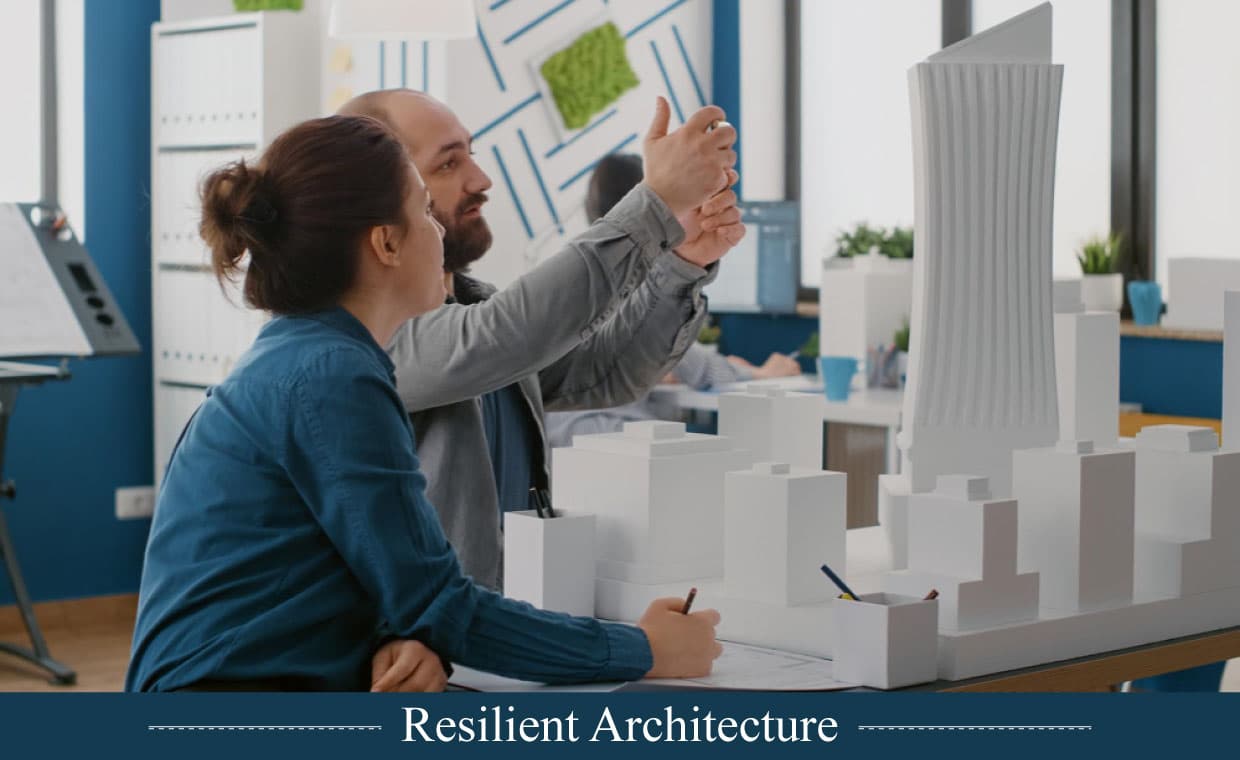
The construction industry plays a key role in shaping where we live and work. With climate change leading to more frequent and severe weather events, the need to make buildings stronger has become more important than ever. This can be achieved by using design strategies for resilient buildings during building planning. Buildings are not just shelters; they are vital investments that protect communities and economies. Natural disasters like earthquakes and hurricanes are challenging traditional building methods, making it vital for architects, engineers, and policymakers to focus on creating structures that can withstand these pressures and make resilient buildings.
Various approaches to strengthening buildings against environmental stress include new materials and design strategies that improve durability. Technology that monitors and predicts building strength is also playing an important role. Additionally, sustainable practices are being integrated to protect the environment while ensuring the resilience of structures, with engineering companies offering essential expertise in implementing these solutions.
Gharpedia brings you a simple guide on how resilient architecture can be achieved using simple design strategies for resilient buildings, but first let’s understand the environmental stressors that impact structures.
Environmental Stressors Explained
Environmental factors can greatly impact building stability, making it essential to understand both natural and human influences. Natural events like earthquakes, hurricanes, and floods are unpredictable and test a building’s durability, often exposing flaws in traditional construction methods. However, modern techniques, such as seismic retrofitting and flood-resistant designs, help reduce these risks.

On the human side, rapid urbanization and climate change have worsened conditions, putting additional strain on infrastructure. Expanding cities reduce green spaces, leading to more heat and water runoff, while climate change increases the frequency and intensity of extreme weather. Addressing these challenges requires innovative engineering solutions and updated policies to ensure long-lasting, resilient buildings.
Design Strategies for Resilient Buildings
Here are some common design strategies for resilient buildings
A) Innovative Materials for Improved Durability
The use of new materials is revolutionizing the construction industry, focusing on stronger, longer-lasting buildings. High-performance concretes are designed to be both stronger and less absorbent, helping structures last longer and cutting down on maintenance. Steel alloys, made with advanced chemical blends, offer superior resistance to corrosion and stress, making them perfect for buildings in coastal or industrial areas.
Composite materials, which combine different elements, are lightweight yet strong, ideal for regions with seismic activity. These cutting-edge materials shield structures from harsh conditions, leading to a more resilient, sustainable future for construction and redefining building standards worldwide.
B) Design Strategies for Resilient Architecture
Architectural and engineering design principles are key strategies for making buildings resilient to environmental stress. Base isolation, for instance, is a technique used in earthquake-prone areas. It lets the building move separately from its foundation, reducing earthquake forces on the structure. Aerodynamic shaping helps reduce wind stress on tall buildings, especially as cities grow upward.

Modular design adds flexibility, allowing parts of a building to be replaced or repaired without affecting the whole structure. These strategies not only strengthen buildings but also allow architects and engineers to balance style with practical, resilient design. In an unpredictable environment, these tools are essential for creating sturdy infrastructures.
C) Technology in Building Reinforcement
In building reinforcement, technology plays a vital role in assessing and boosting resilience against various stressors. Utilising available technology is an important design strategy for resilient buildings. Smart technologies, like sensors embedded in structures, continuously monitor building health, detecting early signs of wear or damage not easily visible. This real-time data enables engineers to make informed maintenance decisions, reducing the risk of structural failures.
Building Information Modeling (BIM) goes further by creating detailed digital models, allowing for in-depth analysis, optimization, and better long-term planning. Predictive analytics, using historical data, forecasts vulnerabilities before they become serious issues. Together, these tools enable smarter, proactive building management, ensuring stronger, more resilient infrastructure capable of withstanding both environmental and structural challenges.
D) Implementing Sustainable Reinforcement Practices

Integrating sustainability into construction is more than a trend—it’s an important shift combining eco-conscious practices with structural durability. Materials like recycled steel and bio-based composites significantly reduce waste and carbon emissions, while also offering enhanced durability through advanced engineering.
Techniques such as green roofs, which absorb rainwater and provide insulation, and natural ventilation systems, further boost energy efficiency and reduce resource consumption. These sustainable practices not only strengthen buildings against environmental challenges but also promote healthier ecosystems. Embracing these methods showcases a long-term commitment to creating resilient architecture, and future-proof infrastructures amid increasing climate risks.
Conclusion
As the construction industry adapts to modern challenges, combining resilience with sustainability is essential for future-proofing buildings. Applying the aforementioned design strategies for resilient buildings, the longevity of buildings is increased. With climate change and urbanization intensifying environmental pressures, new materials and design strategies are helping structures withstand natural disasters like earthquakes and hurricanes. Smart technologies offer real-time monitoring and predictive analysis, allowing for proactive maintenance and improved durability. Sustainable practices, such as using recycled materials and energy-efficient systems, ensure that building reinforcements are not only strong but environmentally friendly. Together, these innovations lay the foundation for stronger, more adaptable infrastructures capable of enduring future challenges by creating resilient buildings.
Also Read:






























